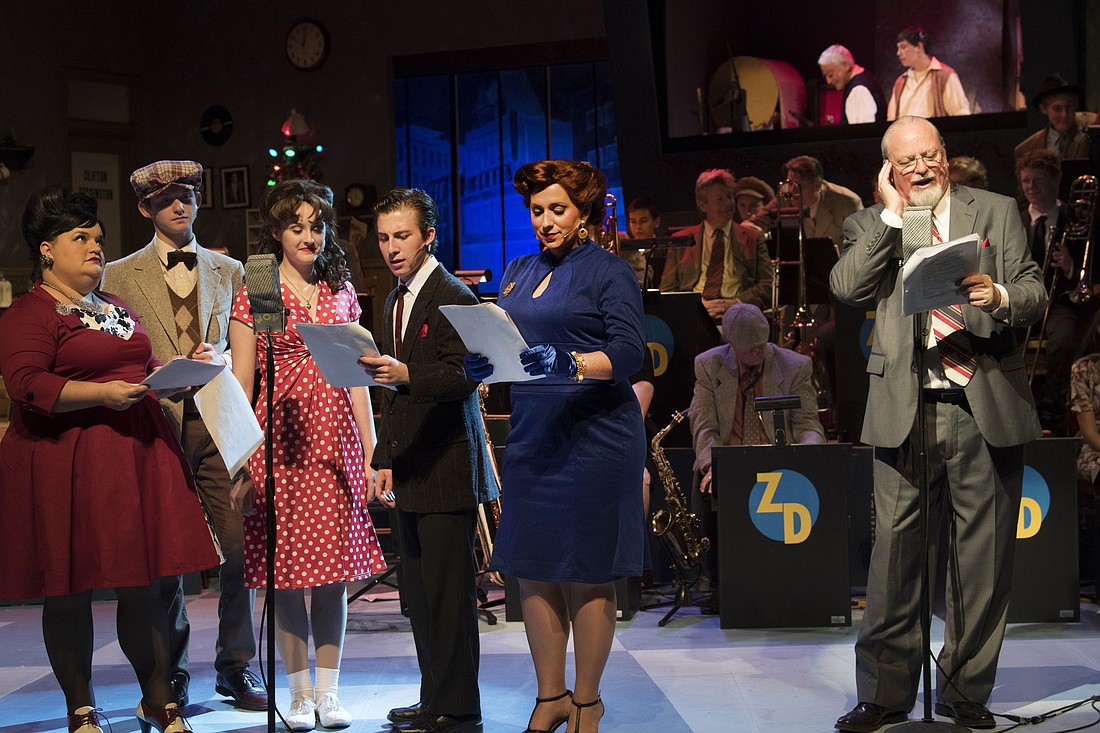- May 10, 2025
-
-
Loading

Loading

The Players is tuning into Walton Jones’ “The 1940s Radio Hour.” Without being coy, the musical’s title tells you exactly what to expect. It’s a one-hour radio show in the 1940s. No surprises there.
The broadcast in question is the “Mutual Manhattan Variety Cavalcade” on the WOV radio station in New York City, and both show and station were very real. The action unfolds on the evening of Dec. 21, 1942, in the dark days of America’s early involvement in World War II. Supposedly, the program is a live broadcast of singers and musicians performing for a studio audience. (Which explains the flashing “Applause” signs.) They’ll also be sending a morale-boosting recording of the show to our troops overseas.
That premise creates instant expectations. You figure the broadcast will hit the airwaves. In between music numbers, you’ll get glimpses of the performers' lives. And there’s some of that.
You see an alcoholic Sinatra-wannabe lead singer (Steve McAllister), a stressed-out, authoritarian stage manager (Craig Engle); a back-up singer who wants first billing (Neal Tilden); a delivery boy with dreams of show-biz (Joshua Devine); a gum-chewing bombshell of a female lead vocalist (Lindsay MacConnell); a boy-girl duo (Stevie Romero and Connie Miller) with stars in their eyes and love in their hearts; and a trumpet player (Victor Mongillo) who will soon be leaving his horn behind and flying off to war.
The stories behind these stock characters are potentially interesting. But the story isn’t the story here. The music is. Despite the thin dramatic veneer, this is a music revue, plain and simple. On that score, you’ll hear some excellent tunes, including “Boogie Woogie Bugle Boy,” “Blue Moon” and “That Old Black Magic.” All that great old big-band music fills the air. And, despite their elaborate background stories, the characters stay in the background. I figure that’s the playwright’s intent. But if you’re looking for deeper involvement, stop looking.
There are some decent bits of business and character insights, don’t get me wrong. Romero is hilarious when he’s roped into a girl-group performance of “Boogie Woogie Bugle Boy.” There’s also a subtle running gag where his bobby-soxer girlfriend drinks Coca Cola, and the show’s sponsor is Pepsi. MacConnell turns up the heat as a sizzling chanteuse who bravely swirls and twirls her chewing gum to clue you in on her character’s mood. Props also to McAllister’s Johnny Cantone, the lush, louche lounge lizard whose singing career is going nowhere. The personal glimpses are intriguing, but I wanted a little bit more.
Director/choreographer Barry Ayers does a snappy job with the material he’s given. His dances unfold in the universe of the musical and flow seamlessly with the clock-watching action of the radio performers. They’re on the air and have to steal their few interactions in the seconds between precisely timed bits.
Ken Junkins’ lovingly detailed set evokes the nooks and crannies of a shabby 1940s radio station. Jared E. Walker’s spiffy costumes recall an era when you had to be a snappy dresser even if you worked in radio.
Bottom line? It’s all about the music. And the music is good. Alan Corey’s musical direction and a stunning horn section (of students on loan from the Pine View music department) bring the lush, fat sound of the Big Band era to life.
This upbeat musical lovingly conveys the happy, frenzied shenanigans of old-time radio — low-rent sound effects included. If you want to escape the tensions of 2017, this slice of 1942 awaits. But it’s not escape entirely. Seen dimly through a nostalgic haze, World War II may be out of sight, but it’s never out of mind.
They definitely got that part right.